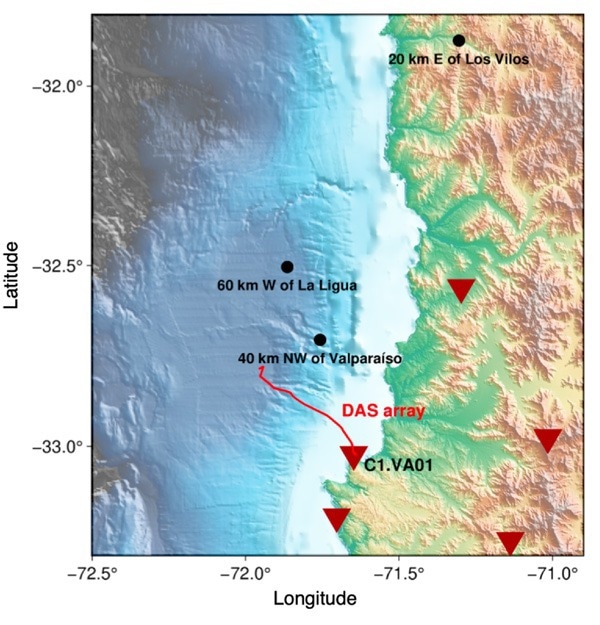The scarcity of offshore seismic stations in densely populated coastal regions, where some of the world's most seismically active areas are situated, presents a substantial challenge for earthquake early warning systems (EEW). In a recent study published in The Seismic Record, researchers have unveiled how disused fiber optic cables originally designed for telecommunications can be repurposed for offshore EEW.
 Map of the study area in Chile. Red curve is the DAS array, black dots are earthquakes, dark red triangles are permanent seismic stations. Image Credit: TSR doi.org/10.1785/0320230018
Map of the study area in Chile. Red curve is the DAS array, black dots are earthquakes, dark red triangles are permanent seismic stations. Image Credit: TSR doi.org/10.1785/0320230018
Over a four-day span, Jiuxun Yin, formerly a researcher at Caltech and currently with SLB, along with colleagues, collected seismic data from 8,960 channels along a 50-kilometer submarine telecommunications cable connecting the United States and Chile. This method, known as Distributed Acoustic Sensing (DAS), harnesses the intrinsic imperfections within extended optical fibers, effectively transforming them into thousands of microscopic seismic sensors.
The team utilized this cable data to estimate the magnitudes of two offshore earthquakes (measuring 2.7 and 3.3 in magnitude) and one onshore earthquake (measuring 3.7 in magnitude) that occurred during the research period.
Jiuxun Yin, a postdoctoral scholar who was formerly affiliated with the California Institute of Technology, expressed his surprise, stating, "While we did expect some improvements due to the offshore placement of the DAS array, the actual speed gains were beyond our initial projections. The key advantage is the array's offshore location, which eliminates the need to wait for seismic waves to reach land-based stations."
The region offshore from Chile bears similarities to the Cascadia region situated offshore from Canada and the U.S. Pacific Northwest. Both areas encompass active subduction zones, where tectonic plates collide, with one plate subducting beneath another, historically giving rise to some of the most significant and devastating earthquakes in history. Even off the coast of Southern California, numerous faults have experienced earthquakes measuring 6 or higher on the magnitude scale. In all these densely populated coastal regions, the implementation of offshore earthquake early warning systems could play a pivotal role in safeguarding lives and property.
Yin pointed out the primary motivation behind selecting this particular cable, stating, "The primary reason for selecting this cable is Chile's elevated seismic risk. The region experiences frequent offshore earthquakes and has been affected by several significant magnitude 8+ earthquakes in history, including the largest ever recorded in 1960. Given the high seismic risk and potentially devastating impacts of a large earthquake, there's a pressing need for a reliable offshore earthquake early warning system in Chile."
The research team employed a deep learning artificial intelligence model, trained and validated using prior seismic and DAS data, to identify earthquake waves within the DAS data of this offshore cable. "In the specific case of DAS, the volume of data collected is substantial. For real-time applications like EEW, pre-trained deep learning models provide a highly efficient and reliable option," Yin explained. He noted, however, that other traditional seismological methods of detecting earthquakes can still be effective in processing DAS data through automation.
Yin emphasized the necessity for researchers to acquire more data, particularly from larger magnitude earthquakes, to effectively develop and test EEW algorithms. Furthermore, he stressed the importance of obtaining information on how DAS instruments respond before constructing a real-time EEW system that integrates with existing frameworks.
There are more than 1,500 cable landing stations around the globe, and the progress in technology permits the use of operational cables and adding DAS systems without affecting telecommunications data transportation. We believe that this opens up a host of exciting research opportunities, and we are eager to explore these in future studies. We are looking for close interactions with cable owners, environmental agencies, and policymakers to scale the DAS-EEW for the benefit of coastal communities
Jiuxun Yin, Postdoctoral Scholar, California Institute of Technology
Journal Reference:
Beckham, J. L., et al. (2023) Molecular machines stimulate intercellular calcium waves and cause muscle contraction. The Seismic Record. doi:10.1038/s41565-023-01436-w